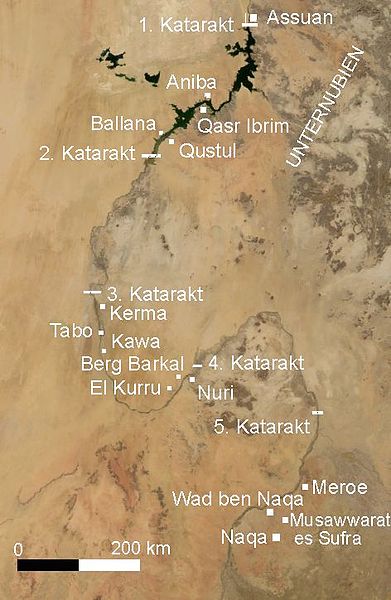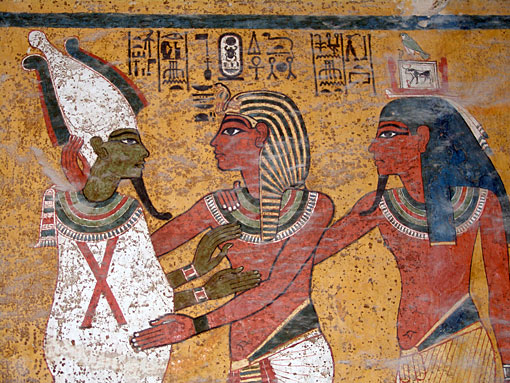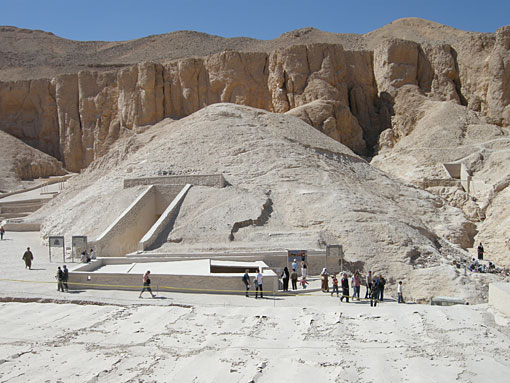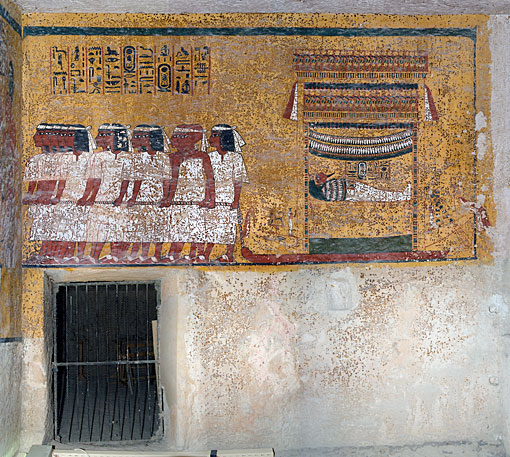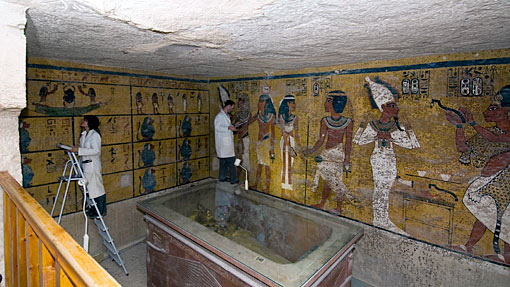Dinastía XXV de Egipto
De Wikipedia, la enciclopedia libre
La dinastía XXV de Egipto, o Kushita (c. 747 a 656 a. C.) es originaria de la ciudad-estado de Napata (Kush). Desde allí el primer rey de esta dinastía, Alara, invadió y conquistó toda Nubia superior. El templo de Amón de Dyebel Barkal se convirtió en el centro religioso alrededor del cual se constituyó una aristocracia local cuyos jefes se hacían enterrar en la necrópolis vecina de El Kurru, y terminaron por constituirse en dinastía; el primer soberano del que se conoce el nombre es Alara, pero parece que sería en realidad el séptimo de la dinastía. Al final de su reinado, desde Meroe hasta la tercera catarata del Nilo estaban bajo poder de su sucesor, Kashta.
Esta dinastía fue coetánea de la XXII, XXIII y XXIV, hasta que, en 747 a. C., sus reyes consiguieron controlar el Alto Egipto. En 715 a. C. reunificaron el país y se mantuvieron como la única dinastía reinante. Su origen los hará llamar faraones negros, faraones etíopes o también faraones kushitas. En 762 a. C. el reino de Sais resurgió, pero siguió siendo vasallo de los kushitas. Esta dinastía es considerada por la mayoría de los historiadores la época final del tercer periodo intermedio de Egipto.
Contenido |
Antecedentes [editar]
Egipto siempre consideró necesario controlar el país de Kush (Nubia), tanto para proveerse de materiales como para proteger sus rutas comerciales, y lo incorporó a la corona, convirtiéndolo en virreinato, en el siglo XVI a. C. El territorio pasó por una egiptización, con periódicas visitas de los faraones y sus visires, la construcción de numerosos templos con la consiguiente llegada del clero, y el envío de los príncipes a la corte para ser educados.
Tras la muerte de Ramsés I, la inestabilidad política hizo que los kushitas se desentendieran de sus vecinos norteños y sus peleas por el poder, creándose un reino independiente en la Alta Nubia con capital en Napata, que fue creciendo a costa de Egipto. Durante siglos, los reyes mantuvieron las costumbres egipcias, aunque no la religión. Pero tomaron ejemplo del arte, la arquitectura, la escritura. Mantuvieron costumbres como la momificación, las tumbas piramidales y, lo más importante, la noción de ser los herederos de los faraones, descendientes del dios Amón que tenía una residencia en Napata. Tanto es así, que en el siglo VIII a. C., Kashta, tras conquistar la Baja Nubia hasta llevar la frontera a la primera catarata, se coronó con una titulatura plenamente egipcia. Su hijo Piye, reclamó todo Egipto.
La conquista [editar]
Piye se lanzó a la "recuperación" del territorio egipcio en el año tercero de su reinado, proclamando su soberanía sobre los gobernantes del norte.
Comenzó a involucrase en los asuntos del Alto Egipto y llegó a tener cierta influencia política en la zona; su sucesor, Pianjy, comenzó la conquista de Egipto pero Tefnajt, gobernante de Sais le opuso resistencia y creó una poderosísima coalición para hacerle frente, aunque fue vencido y Pianjy reunificó bajo su control el Alto Egipto y la zona central de Egipto, adoptando la titulatura de faraón, por lo que se le considera el primer faraón de esta dinastía. Su sucesor, Shabako, luchó para evitar que Egipto fuera conquistado por Sargón II de Asiria, y lo consiguió, lo que aprovechó para ocuparse de construir monumentos y dedicarse más a las letras.
El siguiente rey, Shabitko, rompe la política de paz de sus predecesores y se enfrenta a Asiria. Eso provoca que durante el reinado de su sucesor, Taharqo, los asirios intenten conquistar Egipto, cosa que lograrán en el año 671 a. C., conquistando Menfis, expulsando a Taharqo e imponiendo a Necao I como faraón, que inaugura la vigésimo sexta Dinastía. Desde el exilio, Taharqo promovió muchas revueltas.
Su sucesor Tanutamani reconquistó Egipto, pero los asirios le obligaron a marchar del Bajo Egipto limitando sus territorios al Alto Egipto, hasta que las tropas de Psamético I entraron pacíficamente en Tebas en 656 a. C. Tanutamani solo mantendrá bajo su mando Nubia hasta el año 653 a. C., cuando murió.
Gobierno [editar]

A pesar de proceder de un ambiente étnico diferente, los cinco faraones nubios no se consideraban invasores, sino unificadores de un gran Egipto: el Alto y Bajo Egipto de un lado y Kush de otro. Para indicarlo, añadieron otra cobra al uraeus (la cobra de la corona). Los reyes nubios se consideraron representantes genuinos de las tradiciones, y se dedicaron a la construcción con cierto carácter arcaico, respetando escrupulosamente los hábitos y las instituciones; se afirmaron como plenamente egipcios, guardando al mismo tiempo su apariencia de negros africanos en los retratos. Ejercieron su control sobre los sacerdotes locales obligándoles a admitir nubios entre sus filas: En Tebas, la divina adoratriz tuvo que adoptar para sucederle una hija de Kashta, Aménardis, y los príncipes kushitas se integraron en el clero de Amón junto a las grandes familias de tebanas. El considerado primer faraón de esta dinastía, Sabacon o Shabaka, reinó desde Menfis.
A partir de este período se manifestó una intensa actividad intelectual y artística que buscaba sus referencias en las formas antiguas del pasado, en particular en el Antiguo Imperio. El poder kushita, deseoso de integrarse en la tradición institucional faraónica y de mezclarse con las élites egipcias, reanudó una política activa en favor de los templos.
La dinastía XXV en los antiguos textos [editar]
Manetón, según Julio Africano y Eusebio de Cesarea (versión de Sincelo y armenia), solo comenta que la dinastía XXV consistió en los siguientes tres reyes etíopes:
- Sabacon, quien tras capturar a Bokkoris, lo quemó vivo y reinó 8 (o 12) años.
- Sebijos (o Sebikos), su hijo, que reinó 14 (o 12) años.
- Tarcos (Taracos o Saraco), que reinó 18 (o 20) años.
No menciona ni al primer rey, Pianjy, ni al último rey, Tanutamani, aunque existen inscripciones que refrendan la existencia de ambos.
Esta dinastía es considerada, por la mayoría de los egiptólogos, el final del Tercer periodo intermedio de Egipto: las dinastías XXI, XXII, XXIII, XXIV y XXV.
Faraones de la dinastía XXV de Egipto [editar]
| Nombre común | Nombre de Nesut-Bity | Nombre de Sa-Ra | Comentarios | Reinado |
|---|---|---|---|---|
| Alara | Ireru Alara | Rey de Kush | 780 - 760 a. C. | |
| Kashta | Maara | Kashta | Rey de Kush | 760 - 747 a. C. |
| Pianjy Piye | Menjeperra | Pianjy | Faraón fundador de la dinastía XXV | 747 - 716 a. C. |
| Shabako Sabacon | Neferkara | Shabako | 716 - 702 a. C. | |
| Shabitko Sebicos | Dyedkaura | Shabitko | 702 - 690 a. C. | |
| Taharqo Tarcos | Junefertumra | Taharqo | 690 - 664 a. C. | |
| Tanutamani Tenutamón | Bakara | Tanutamani | 664 - 656 a. C. |
- Cronología según Kenneth Kitchen.
- Aidan Dodson, Rolf Krauss, David Aston, y Karl Jansen-Winkeln retrasan las fechas unos cinco años.
Cronología de la dinastía XXV [editar]
Cronología estimada por los siguientes egiptólogos:
- Faraón que funda la dinastía: Pianjy
- 752-717 (Dodson)
- 751-716 (Drioton)
- 747-716 (Aston, Grimal, Arnold, Shaw)
- 746-713 (von Beckerath)
- 735-712 (Redford)
- Último faraón: Tanutamani, 664 - 655/53 a. C. (von Beckerath)
Cronograma [editar]

Referencias [editar]
- Referencias digitales
- (en inglés) http://www.digitalegypt.ucl.ac.uk//Welcome.html
- (en inglés) http://www.ancient-egypt.org/index.html
- (en inglés) http://www.narmer.pl/indexen.htm
- (en inglés) http://www.phouka.com/pharaoh/pharaoh/pharaohs.html
- (en alemán) http://www.eglyphica.de/egpharaonen
- (en francés) http://2terres.hautesavoie.net/cegypte/texte/chronolo.htm
Enlaces externos [editar]
 Wikimedia Commons alberga contenido multimedia sobre la dinastía XXV de Egipto.
Wikimedia Commons alberga contenido multimedia sobre la dinastía XXV de Egipto.- Genealogía, Reyes y Reinos: Dinastía XXV de Egipto
| Dinastía precedente | Tercer periodo intermedio de Egipto | Dinastía siguiente |
|---|---|---|
| Dinastía XXIV | Dinastía XXV | Dinastía XXVI |
Categoría: Dinastía XXV
Twenty-fifth dynasty of Egypt
From Wikipedia, the free encyclopedia
| Dynasties of Ancient Egypt |
The Twenty-Fifth Dynasty of Egypt, also known as the Nubian dynasty or Kushite Empire, was a line of rulers originating in the Kingdom of Kush. They reigned in part or all of Ancient Egypt from 760 BC to 656 BC.[1]. The dynasty began with Kashta's invasion of Upper Egypt and culminated in several years of war with the Assyrians that forced the Kushites back to their homeland. The twenty-first, twenty-second, twenty-third, twenty-fourth and twenty-fifth dynasties of Ancient Egypt are often combined under the group title, Third Intermediate Period.
Contents |
[edit] Rulers
The known rulers, in the History of Egypt, for the twenty-fifth dynasty are the following
| Name | Dates |
|---|---|
| Kashta | c. 760 BC – c. 752 BC |
| Piye | c. 752 BC – 721 BC |
| Shabaka | 721 BC – 707 BC |
| Shebitku | 707 BC – 690 BC |
| Taharqa | 690 – 664 BC |
| Tantamani | 664 – 656 BC (died 653 BC) |
Alara, the first known Nubian king and predecessor of Kashta was not a 25th dynasty king since he did not control any region of Egypt during his reign. While Piye is viewed as the founder of the 25th dynasty, some publications may include Kashta who already controlled parts of Upper Egypt. A stela of his was found at Elephantine and Kashta likely exercised some authority at Thebes since he held enough influence to have his daughter Amenirdis IDivine Adoratrice of Amun there. adopted as the next
[edit] Piye
The twenty-fifth dynasty originated in Kush (Nubia) presently in north Sudan at the city-state of Napata, whence they invaded and took control of Egypt under Piye (spelled Piankhi in older works). Manetho does not mention either the first king, Piye, or the last king, Tantamani, although inscriptions exist to attest to the existence of both.
[edit] Shebitku
The following chronology follows recent research by Dan'el Kahn [2] which suggests that Shebitku was king of Egypt by 707/706 BC. This is based on evidence from an inscription of the Assyrian king Sargon II, which was found in modern day Northwestern Iran and dated to 706 BC. This inscription calls Shebitku the king of Melunha, and states that he sent back to Assyria, a rebel named Iamanni in handcuffs. Kahn's arguments have been widely accepted by many Egyptologists including Rolf Krauss, and Aidan Dodson [3] and other scholars at the SCIEM 2000 (Synchronisation of Civilisations of the Eastern Mediterranean in the Second Millennium B.C.) project with the notable exception of Kenneth Kitchen and Manfred Bietak at present.
[edit] Taharqa
Starting from the reign of Taharqa onward, the kings of this dynasty were driven back into Nubia, at first by the Assyrians, then by the kings of the Twenty-Sixth Dynasty. Their successors came to settle in Nubia, where they established a kingdom at Napata (656 - 590 BC) then later, at Meroë (590 BC - 4th century AD).
[edit] See also
[edit] References
[edit] Sources
- Török, László (1998). The Kingdom of Kush: Handbook of the Napatan-Meriotic Civilization. Leiden: BRILL. pp. 589 Pages. ISBN 9-00410-448-8.
[edit] External links
- (French) Voyage au pays des pharaons noirs Travel in Sudan : pictures and notes on the Nubian history
